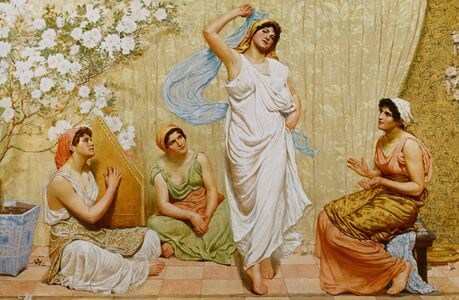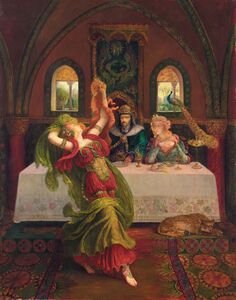Category:Salome--dance (subject)

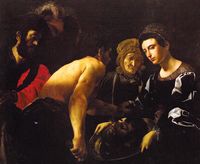



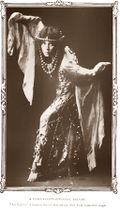


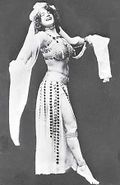
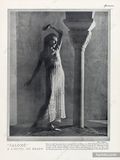
Salome (dance) -- Dance of Salome -- Dance of the Seven Veils.
<Fiction : Salome (cinema) -- Salome (music) -- Salome (literature) -- Salome (art)>
Overview
The story of Salome's dance was born as one of the legendary elements surrounding the Death of John the Baptist. In the Gospels of Mark and Matthew the unnamed daughter of Herodias "danced" before her uncle (and now step-father) Herod Antipas. He was so pleased to grant her any wishes, including the head of John the Baptist.
Christian iconography represented the scene. Hence, whoever performs Salome is expected to be a dancer (at least, also a dancer), even when she is primarily an actress or a singer.
In 1895 Loie Fuller was the first solo dancer to present a Salome piece and she did it in line with the "biblical" view of Salome as an innocent child. But the great success of Oscar Wilde's play (in Paris [1896] and Berlin [1902]) and Richard Strauss's opera (Berlin [1905]) changed radically the popular view of Salome, from innocent chid to femme fatale.
In Wilde and Strauss the dance of Salome became the epitome of her seductiveness. The "colonial" fashion and prejudice of the time made them to reimagine her dance as a lascivious "Oriental" dance--the Dance of the Seven Veils. Both classical and vaudeville dancers contributed to create the tragic character of a seductive and perverse woman that ultimately destroys herself with the object of her own desires. They offered solo performances, or substituted actresses and singers who were unable or unwilling (for reasons of decency) to perform the Dance of the Seven Veils. And when professional dancers were not involved, actresses and singers turned into dancers, offering some remarkable dancing performances on stage or on the screen.
The Salome craze, or Salomania (as it was renamed by Percival Polland in the New York Time in late August 1908), reached its peak in the years 1907-09, when the Dance of Salome attracted the attention of the most famous ballerinas, becoming for some time a fever that spread in all Europe and the United States. It started in Europe with The Vision of Salome by Canadian-American dancer Maud Allan, which premiered in Vienna in December 1906 and then appeared in some of the major European theaters, in Budapest, Berlin, Marienbad, finally to triumph at the Palace Theatre in London in March 1908. In line with the new identity of femme fatale of the character, in November 1907 Loise Fuller performed in Paris a very different Salome from her first work on the subject, on music specifically composed by Florent Schmitt.
In the meantime, Strauss's Salome had been first performed in New York on 22 January 1907. As was common practice, dancer Bianca Froelich substituted soprano Olive Fremstad during Salome's Dance of the Seven Veils. Her realistic performance contributed to the scandal and the show was cancelled within days. By public demand, Froelich immediately began performing her opera choreography at the Lincoln Square Variety Theater before wildly enthusiastic audiences. Almost overnight, all Oriental dancers in the vaudeville became "Salome dancers". The film If You Had a Wife Like This, released on 23 May 1907, included a "Salome Dance" and so did the Ziegfeld Follies of 1907, performed by Mdlle. Dazie. The show opened on 9 July 1907 at the Jardin de Paris in New York.
The scandal of the New York premiere and the success of these early performances by Bianca Froelich and Mdlle. Dazie inspired Gertrude Hoffman to offer her own interpretation of the Vision of Salome. In April 1908 she traveled to England with her husband with the specific goal of getting Allan's dance, which was enjoying a lasting success in London. On 13 July 1908 Gertude Hodffman's show opened at Hammerstein's Paradise Garden Roof Theater. It was an overnight sensation and every vaudeville theatre staged its own Salome dance. In the Summer 1908 newspapers and journals in the United States denounced an outbreak of "The Salome Epidemic": "There are no many dancers appearing as the daughter of Herodias that it is impossible to make more than a guess at their number. There is hardly a vaudeville house that cannot boast its own Salome, whether it be Hammerstein's Roof Garden, the Casino, the Alhambra, or a third or four class hall" (The Sketch 63 [1908] 345). Among the most celebrated American vaudeville dancers to specialize as "Salome dancers" were Hilde Caroll, La Sylphe, Lotta Faust, Vera Olcott (Theatre Unique), Eva Tanguay, La Belle Zola, La Petite Adelaide, and Aida Overton Walker. The cinema's contribution to "Salomania" included in 1908 lavish performances by Florence Lawrence and Stacia Napierkowska. When in 1909 Strauss's Salome returned at New York at the Manhattan Opera House, it was a triumph. Enthusiastic audiences rushed to see soprano Mary Garden performing herself a much daring version of the Dance of the Seven Veils.
Even when the "epidemic" was over, Salome remained a fashionable presence on stage and on screen. New productions of Schmitt's ballet were performed in Paris in the 1910s and 1920s. In 1912 in a private performance at Palazzo Barberini before the Prince of San Faustino, Mata Hari used the Strauss music and played a topless and laughing Salome. On the screen, some of most popular actresses competed to offer the definitive portrait of Salome, including Vittoria Lepanto (1910), Theda Bara (1918), and Alla Nazimova (1922).
After some pause in the 1930s, the story of Salome once again returned to be an inspiring force for dancers and choreographers in the late 1940s.
Many famous choreographers have recreated Salomé's Dance of the Seven Veils for productions of either the Wilde play or the Strauss opera, including Maurice Bejart, Mark Morris (Seattle Opera, 1986), and Doug Varone (Metropolitan Opera, 2004). Some have created solo performances or ballets, based on the music of Strauss or other musicians who like Florent Schmitt, have composed music specifically for the Salome dance.
Following the example of Mary Garden, some sopranos have distinguished themselves not only for their vocal skill but also as celebrated performers of the Dance of the Seven Veils. Among them are Ljuba Welitsch (in the 1940s), Maria Ewing (in the 1980s), Catherine Malfitano (in the 1990s), Karita Mattila and Nadja Michael (in the 2000s).
Among the most notable actresses to perform Salome as a dancer on screen are Rita Hayworth and Brigid Bazlen. Only in Pasolini's film The Gospel according to Matthew (1964), Salome, played by 12-year-old Paola Tedesco, was allowed to return an innocent child, playing an innocent, joyful dance before her parents, unaware of the consequences of her action.
While the two typologies of Salome, innocent child or perverse seductress, continue to coexist, in more recent decades a third typology has emerged in some productions that have given a homosexual understanding of the story.
In an interview published by Solomon Volkov in 1985, two years after the death of the choreographer, George Balanchine stated that he always believed that Oscar Wilde was "thinking of a pretty boy" when he wrote of Salome. The first production of Salome to play up a transvestite angle was the Italian film director Luchino Visconti's production of Strauss's opera at the Spoleto Festival in 1961, under the baton of Thomas Schippers. There the Dance of the Seven Veils was performed not by the soprano (Margaret Tynes) or a dancer, but by a group of young men. Choreographers Lyndsay Kemp in 1977 and Maurice Bejart in 1983 even more explicitly linked the character of Salome to transvestitism by adapting the role for a male dancer. Russell's film Salome's Last Dance (1987) located the representation of Wilde's work in an all-male brothel, revealing at the climax of the Dance of the Seven Veils that the "female" protagonist (Imogen Millais-Scott) was transgender.
Other versions of the story were choreographed by
- Loie Fuller (mus. Florent Schmitt, Paris, 1907),
- < Alexander Gorsky (1871-1924), Salome's Dance (mus. R. Strauss, Moscow, 1921) >
- Kassian Goleizovsky (1924)
- Ruth St. Denis (1931)
- Lester Horton (between 1931 and 1950)
- Ruth Sorel (1933)
- Serge Lifar (1905-1986) (mus. Richard Strauss, Monte Carlo, 1946),
- Birgit Cullberg (1908-1999) (mus. H. Rosenberg, Stockholm, 1964),
- Joseph Lazzini (1968)
- Peter Durrell (mus. Hindemith, Scottish Theatre Ballet, 1970), Hérodiade (Salome / 1970 @1944 Hindemith / Durrell), ballet
- Maurice Bejart (1970)
- Carmen de Lavallade and James Truitte (1973)
- Lindsay Kemp (b.1939) (mus. various, New York, 1975?) (all male version, 1977)
- Flemming Flindt (mus. Davies, Copenhagen, 1978),
- Billy Cratty (1986) Transported Salome into the roaring Twenties
- Josephine Barstow || Salome's Dance (1986 Morris / @1905 Strauss), ballet || Choreography of Mark Morris for a representation of Strauss's opera Seattle Opera House, 1986, performed by the soprano. Conductor Stefan Minde
- Salome (1998 Murphy / Askill), ballet -- Graeme Murphy (b.1950), Salome (mus. various, Sydney Dance Company, 1998). (1993? and 1998?)Michael Askill (mus.)
Bibliography
- Marlis Schweitzer, "The Salome Epidemic: Degeneracy, Disease, and Race Suicide," in The Oxford Handbook of Dance and Theater (Oxford 2015), pp.
- Debra Craine, and Judith Mackrell (eds.), The Oxford Dictionary of Dance, 2010.
- Clair Rowden (ed.), Performing Salome, Revealing Stories (Routledge, 2013)
- Davinia Caddy, "Variations on the Dance of the Seven Veils," Cambridge Opera Journal 17.1 (2005) 37–58 [1]
- Toni Bentley, Sisters of Salome (New Haven, 2002).
- William Tydeman and Steven Price, Wilde: Salome (Cambridge, 1996), 136–51
- Richard Bizot, "The Turn-of-the-Century Salome Era: High- and Pop-Culture Variations on the Dance of the Seven Veils," Choreography and Dance 2 (1992) 71–87
- Judith Lynne Hanna, Dance, Sex, and Gender: Signs of Identity, Dominance, Defiance, and Desire, University of Chicago Press, 1988
- Richard Bizot, "Lester Horton's Salome, 1934-1953 and after," Dance Research Journal 16.1 (Spring, 1984), pp. 35-40
- "The Vulgarization of Salome," Current Literature 45 (1908) 437-440
Oriental dance
Salome's dance
Pages in category "Salome--dance (subject)"
The following 47 pages are in this category, out of 47 total.
1
- Dance of Salome (1462 Gozzoli), art
- Banquet of Herod (1465 Lippi), art
- Salome's Dance (1544 Ligorio), art
- Salome's Dance (1879 Gottlieb), art
- The Dance of Salome (1885 Fowler), art
- Salome (1895 Sylvestre, Pierné, Fuller), ballet
- Salome (1905 Picasso), art
- The Vision of Salome (1906 Allan), solo dance
- Tanz der Salome (Salome's Dance / 1906 Messter), short film
- If You Had a Wife Like This (1907 Biograph), short film
- Salome's Dance (1907 Dazie), solo dance
- Salome's Dance (1907 Froelich), solo dance
- Salome (1907 Gaumont), short film
- Salome (1907 Lubin), short film
- Salome; or, The Dance of Seven Veils (1908 Blackton), short film
- Salomé (1908 Capellani), short film
- Salome's Dance (1908 Faust), solo dance
- L'inconsciente Salomé (Salome / 1908 Feuillade), short film
- A Vision of Salome (1908 Hoffmann), solo dance
- The Remorse of Salome (1908 La Sylphe), solo dance
- Salome's Dance (1908 Olcott), solo dance
- Salome's Dance (1908 Overton Walker), solo dance
- Salome's Dance (1908 Tanguay), solo dance
- The Great Salome Dance (1908 Tyler), short film
- Salomé (1910 Amalou / @1908 Mariotte), Paris production (opera)
- Salome (1910 Falena), short film
- Salome (1914 Bussiere), art
- Salomé (1919 Ruhlmann / @1908 Mariotte), Paris production (opera)
- Salome (1922 Bryant), feature film
- Salome (1934 Horton, Montaya), ballet
- Salome (1937 Horton, Lewitzky), ballet
- The Dance of Salome (1949 Franca / Hartley), TV film (ballet)
- Salome; or, The Face of Violence (1953 Horton, Lavallade), ballet
- Omnibus: Salome (1955 / @1893 Wilde), TV production (play)
- Miss Salome (1955 Truitte / @1953 Horton), ballet
- Salome (1957 @1905 Strauss / Goehr), TV production (opera)
- Salomé (1969 Koralnik / @1893 Wilde), TV production (play)
- Salome; or, The Face of Violence (1973 Truitte / @1953 Horton), ballet
- Salome (1978 Davies / Flindt), ballet
- Salome (1991 Sinopoli, Malfitano / Weigl, Large / @1905 Strauss), video recording (opera)
- (+) Salome (1992 Downes, Ewing / Bailey / @1905 Strauss), video recording (opera)
- Salome (1992 Waart, Barstow / @1905 Strauss), Amsterdam production, video recording (opera)
- Salome (1997 Dohnányi, Malfitano / Bondy, Hulscher / @1905 Strauss), London production, video recording (opera)
2
- Salomé (Salome / 2002 Saura / Baños, Tomatito), film-ballet
- Salome, Spanish ed. (2005 @1893 Wilde / Narros), Seville production (play)
- Salome (2008 Summers, Mattila / @1905 Strauss), New York (Met) production, video recording (opera)
- Salome, Spanish ed. (2016 @1893 Wilde / Chávarri), Madrid production (play)
Media in category "Salome--dance (subject)"
The following 5 files are in this category, out of 5 total.
- 1918 Edwards (film).jpg 330 × 523; 93 KB
- 1945 Lamont (film).jpg 182 × 268; 23 KB
- 1953 * Dieterle (film).jpg 214 × 387; 27 KB
- 1961 Ray N (film).jpg 327 × 475; 46 KB
- 1964 Pasolini (film).jpg 231 × 325; 16 KB







